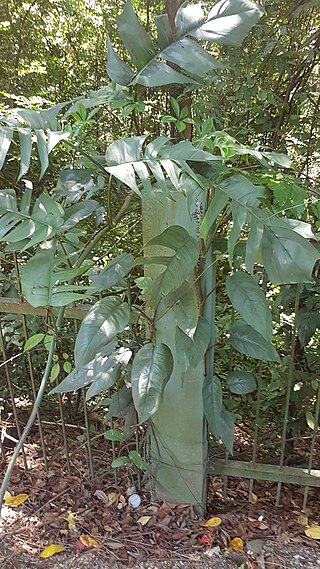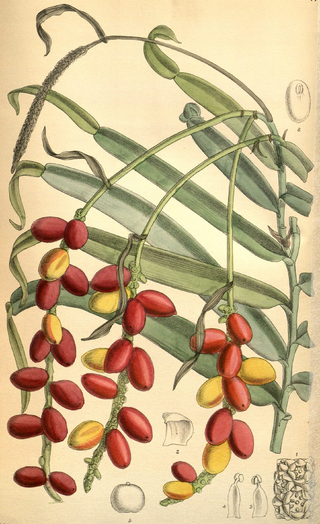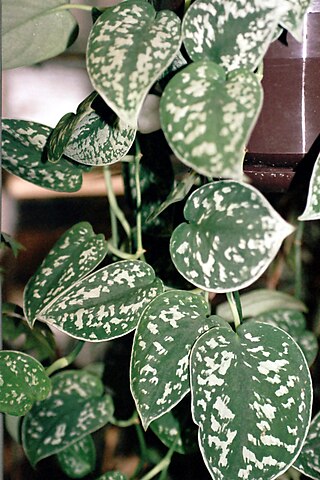
Amorphophallus is a large genus of some 200 tropical and subtropical tuberous herbaceous plants from the Arum family (Araceae), native to Asia, Africa, Australia and various oceanic islands. A few species are edible as "famine foods" after careful preparation to remove irritating chemicals. The genus includes the Titan arum of Indonesia, which has the largest inflorescence of any plant in the genus, and is also known as the 'corpse flower' for the pungent odour it produces during its flowering period, which can take up through seven years of growth before it occurs.

Epipremnum aureum is a species in the arum family Araceae, native to Mo'orea in the Society Islands of French Polynesia. The species is a popular houseplant in temperate regions but has also become naturalised in tropical and sub-tropical forests worldwide, including northern South Africa, Australia, Southeast Asia, South Asia, the Pacific Islands and the West Indies, where it has caused severe ecological damage in some cases.

Arisaema is a large and diverse genus of the flowering plant family Araceae. The largest concentration of species is in China and Japan, with other species native to other parts of southern Asia as well as eastern and central Africa, Mexico and eastern North America. Asiatic species are often called cobra lilies, while western species are often called jack-in-the-pulpit; both names refer to the distinctive appearance of the flower, which consists of an erect central spadix rising from a spathe.

Monstera is a genus of 59 species of flowering plants in the arum family, Araceae, native to tropical regions of the Americas.

Epipremnum pinnatum is a species of flowering plant in the family Araceae. It has many common names, including centipede tongavine and dragon-tail plant. In the Philippines, it is known in Tagalog as tibatib.

Dracontium is a genus of flowering plants similar to those of Amorphophallus. Unlike Amorphophallus which is found in the Old World, this genus has a New World distribution and is native to South America, Central America, southern Mexico, and the West Indies.

Pothos is a genus of flowering plants in the family Araceae. It is native to China, the Indian Subcontinent, Australia, New Guinea, Southeast Asia, and various islands of the Pacific and Indian Oceans.

Rhaphidophora is a genus in the family Araceae, occurring from tropical Africa eastwards through Malesia and Australasia to the Western Pacific. The genus consists of approximately 100 species.

Epipremnum is a genus of flowering plants in the family Araceae, found in tropical forests from China, the Himalayas, and Southeast Asia to Australia the western Pacific. They are evergreen perennial vines climbing with the aid of aerial roots. They may be confused with other Monstereae such as Rhaphidophora, Scindapsus and Amydrium.

Homalomena is a genus of flowering plants in the family Araceae. Homalomena are found in southern Asia and the southwestern Pacific. Many Homalomena have a strong smell of anise. The name derives apparently from a mistranslated Malayan vernacular name, translated as homalos, meaning flat, and mene = moon.

Schismatoglottis is a genus of flowering plants in the family Araceae. Members of the genus are similar in appearance and growth habit to those of the genus Homalomena, but the two genera are not closely related. The primary difference is that the leaves of Schismatoglottis are not aromatic. Schismatoglottis are found primarily in tropical parts of Southeast Asia, New Guinea, and Melanesia. The majority of the species are native to the Island of Borneo.

Scindapsus is a genus of flowering plants in the family Araceae. It is native to Southeast Asia, New Guinea, Queensland, and a few western Pacific islands. The species Scindapsus pictus is common in cultivation.
Anadendrum is a genus of flowering plants in the family Araceae. It is native to China and Southeast Asia.

Cyrtosperma is a genus of flowering plants in the family Araceae. The genus went through considerable taxonomic changes in the 1980s, and as a result is now considered to be native only to Southeast Asia and some Pacific islands. Previously, the genus was believed to be widespread from Asia to Africa and South America, but the African and South American species were subsequently moved into separate genera. Cyrtosperma is now known to be most prominent in New Guinea. The genus Cyrtosperma is unique in this regard because it is the only known big genus in Araceae that is known to be found east of Wallace's line.

Taccarum is a genus of flowering plants in the family Araceae. It is endemic to South America. The genus tends to grow in rocky areas.
- Taccarum caudatumRusby - Bolivia, Peru, Acre State in western Brazil
- Taccarum crassispathumE.G.Gonç. - central Brazil
- Taccarum peregrinum(Schott) Engl. - Paraguay, southern Brazil, Misiones Province of Argentina
- Taccarum uleiEngl. & K.Krause - eastern Brazil
- Taccarum warmingiiEngl. - southern Brazil
- Taccarum weddellianumBrongn. ex Schott - Bolivia, Peru, Paraguay, central and western Brazil
Apoballis is a genus of plants in the Araceae. It is native to Southeast Asia, primarily the Island of Sumatra in Indonesia. Some authorities regard this group as part of the larger genus Schismatoglottis.
- Apoballis acuminatissima(Schott) S.Y.Wong & P.C.Boyce - Sumatra
- Apoballis belophylla(Alderw.) S.Y.Wong & P.C.Boyce - Sumatra
- Apoballis brevipes(Hook.f.) S.Y.Wong & P.C.Boyce - Sumatra, Thailand, Peninsular Malaysia
- Apoballis grandiflora(Alderw.) S.Y.Wong & P.C.Boyce - Sumatra
- Apoballis hastifolia(Hallier f. ex Engl.) S.Y.Wong & P.C.Boyce - Sumatra
- Apoballis javanica(Engl.) S.Y.Wong & P.C.Boyce - Java
- Apoballis longicaulis(Ridl.) S.Y.Wong & P.C.Boyce - Sumatra
- Apoballis mutata(Scort. ex Hook.f.) S.Y.Wong & P.C.Boyce - Myanmar, Sumatra, Thailand, Peninsular Malaysia
- Apoballis okadae(M.Hotta) S.Y.Wong & P.C.Boyce - Sumatra
- Apoballis ovata(Schott) S.Y.Wong & P.C.Boyce - Sumatra
- Apoballis rupestris(Zoll. & Moritzi) S.Y.Wong & P.C.Boyce - Sumatra, Java, Bali, Lombok, Timor
- Apoballis sagittifolia(Alderw.) S.Y.Wong & P.C.Boyce - Sumatra
Epipremnum meeboldii is a species of flowering plant in the genus Epipremnum and the family Araceae.
Epipremnum papuanum is a flowering plant belonging to the genus Epipremnum, and the family Araceae. It exhibits liana growth style.
Epipremnum nobile is a species of flowering plant belonging to the genus Epipremnum and the family Araceae.
Epipremnum obtusum is a species of flowering plant belonging to the genus Epipremnum and the family Araceae.














